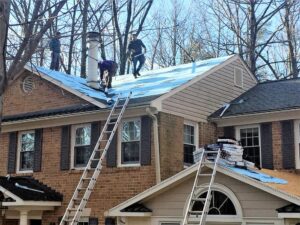Your DIY Spring Home Maintenance Guide

Springtime flowering trees just around the cornerSpringtime and cheery sunshine bring signs of new life to one’s property highlighting all the chores that need to get done around the house. From excess dust that built up over the winter to the dead leaves and gunk clogging your gutters, there are plenty of tasks now that the weather is getting warmer. This helpful guide outlines several DIY or honey-do spring home maintenance projects to help get you started. The following projects/repairs anybody can do, even if you are not handy with a hammer and nail.
contributed by Bret Engle DiyGuys.net, edited by Peggy Golden, ASID
Change Your Air Filters
Spring is the perfect time of year for replacing the home’s HVAC air filters. Clean filters assist with capturing tiny allergens that are blooming in the air with the approaching spring season. Clean filters help your air conditioner run more efficiently, making your home more comfortable and your electric bills less expensive. If you have allergies, avoid inexpensive fiberglass furnace filters and look for versions specifically crafted to catch airborne particles or HEPA filters to ensure you get the best product for your needs. Most HVAC contractors will recommend changing your air filters optimally every 4-8 weeks for best performance of the home’s HVAC system. Today homeowners may opt to use a filter subscription service with new filters regularly mailed to your home.
Check for Roof Damage
Winter storms can do a number on your roof.
Take some time on a clear day to make sure there are no signs of damage that
could lead to a much more expensive and problematic leak going forward. Signs
of a damaged roof include:
- Water spots on the ceiling or on
exterior walls - Granules are filling up your
gutters and coming out the downspout - Shingles are cracking, cupping, or
curling - Some shingles are missing
- Large black stains on the roof
- Wear and tear around chimneys,
vents, pipes, and gutters - Leaks in the attic
- Unexplained increases in energy
costs - Blistering or peeling exterior
paint
Checking for roof damage can be a DIY project, but fixing your roof should be left to professionals. If you need your roof replaced, average costs will run you between $4,900 and $14,100. Ask your neighbors and friends if they have recommendations for local roof contractors they trust. Call multiple contractors and get several estimates before settling on the right person for the job. Major storms with Hail and High Wind speeds can create significant damage to the existing shingles which may qualify for your home owner’s insurance provider to consider a roof replacement. Many roofing companies want no part of insurance work as their standard business operation and will not want to be involved in the extra work of dealing with insurance claims representatives. There are several qualified roofing companies that specialize in identifying insurance claims that will happily assist you and work with your insurance company to get you a new roof replacement when there is significant storm damage. You may not be aware that a major storm was in the area if you were at work or travelling however if you start to see signs of numerous roofs being replaced in your neighborhood it is a sure sign of insurance companies are providing new roofs.

If your insurance company will pay for a complete new roof consider adding a few key upgrades at your expense to improve the value of your home. Upgrades include premium underlayment between plywood and shingles, upgraded architectural shingle styles and aluminum wrap on all the wood rake boards providing less maintenance and protecting wood boards subject to rot, insect and bird damage. Another item to give thought to would be new gutters and downspouts if the existing gutters are old and undersized.
Clean Your Gutters
Cleaning your gutters is a dirty job and bi-yearly
spring/fall cleanings are necessary considering all the dead foliage and debris
that builds up over winter and how vital it is for your gutter system to work
properly during heavy spring rains.
Gutters and downspouts are also an essential part of proper drainage performance
around the home’s foundation. Clear
running gutters and downspouts keep water from building up around the
foundation walls which can cause leaks and wet walls in your basement.
Cleaning your gutters doesn’t take much. Basically you need heavy-duty rubber gloves, a ladder, and a hose. While you are up there, inspect your system including covers and downspouts to check for damage. If you see rust, cracks, or any other signs of excessive wear and tear, have your gutters and downspouts repaired as soon as possible to prevent larger problems in the future.
Even with gutter guards, screen shields or other top over gutter products you need to look during heavy rainfalls for down pouring water in isolated spots from the roof/gutter line around the house. These can correspond with changing or intersecting roof lines and become stress points for the gutters maintaining adequate flow due to excessive build up inside the gutters at critical junctions. Although described as maintenance free these more expensive covered gutters work well for a period of time. However you still need to watch for trouble spots and address them quickly for maintaining proper drainage around the home and preventing other maintenance issues that will be more problematic.
In addition to occasionally cleaning the
interiors of covered gutters the exposed metal top edges of the gutter covers
need to be cleaned from years of built up dirt that will create water flowing
over the top of the cover to the ground.
Home maintenance 101 – it never ends even with maintenance free
products!
Many older homes may not have proper gutters installed at all location where needed or designed to address roof change in heights, gables and property drainage issues. Most have 4” gutters which was the standard for years however today gutters are 6” width and many companies no longer install 4” gutters. If you need new or improved gutter/downspout design systems this article explains the basics well “How to prevent heavy rainwater from jumping the gutter?”
Inspect the Trees
Trees often don’t get enough love, but they add significant value for your property and home. As well as looking great they provide oxygen and assist with reducing heating and cooling bills. This year, do something for these tall friends by checking their health. Look for signs of insect infestations or disease and trim away dead and broken branches to make room for new growth. Keeping your trees healthy helps ensure their health for years to come.
***
A homeowner’s work is truly never done —
especially after winter thaws and it is time for spring maintenance. Changing
your air filters can help with allergies this season. Check for roof damage
that you can get repaired before it turns into a much more expensive problem.
Clear out winter gunk from your gutters and ensure that your entire system is
ready to handle seasonal storms. Finally, inspect your trees’ health and prune
off dead leaves and branches so they have room to grow.







